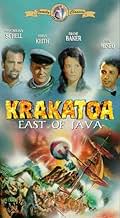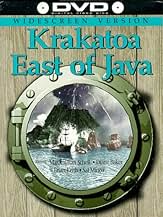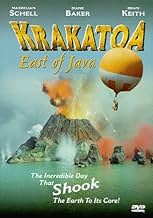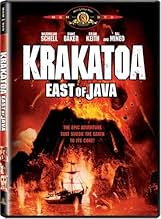NOTE IMDb
5,4/10
1,9 k
MA NOTE
Ajouter une intrigue dans votre langueIn 1883, ship captain Hanson plans a shipwreck salvage mission in The Dutch East Indies to retrieve a cargo of pearls but an unexpected volcano eruption and a state-ordered transport of conv... Tout lireIn 1883, ship captain Hanson plans a shipwreck salvage mission in The Dutch East Indies to retrieve a cargo of pearls but an unexpected volcano eruption and a state-ordered transport of convicts upset his plans.In 1883, ship captain Hanson plans a shipwreck salvage mission in The Dutch East Indies to retrieve a cargo of pearls but an unexpected volcano eruption and a state-ordered transport of convicts upset his plans.
- Nommé pour 1 Oscar
- 1 nomination au total
Jacqueline Chan
- Toshi
- (as Jacqui Chan)
Niall MacGinnis
- Harbor Master
- (as Niall Macginnis)
Histoire
Le saviez-vous
- AnecdotesKrakatoa was actually located west of Java.
- GaffesKrakatoa is, in fact, west of Java.
- Crédits fousThis film was shot using Super Panavision 70 and Todd-AO formats for presentation in single-strip Cinerama. The opening title sequence has the image devided into three frames just like the original three-strip Cinerama.
- Versions alternativesOriginally premiered in Cinerama format at 136 minutes. After tepid reactions, film was cut to 101 minutes and re-released.
- ConnexionsFeatured in Pinball, des filles et des flippers (1980)
Commentaire à la une
A guilty pleasure. Krakatoa, East Of Java's principal claim to fame is its title, infamously and erroneously placing its subject on the wrong side of the island. Directed by Bernard Kowalski, whose rare non-TV credits include Attack Of The Giant Leeches (1959), and SSsssnake (1973), the film is probably his best, aided immensely as it is by some excellent widescreen cinematography, emphasised with convincing location shooting -facts rarely allowed for in usual criticisms of a film which was cut by almost 30 minutes for an American re-release. The special effects, largely achieved through miniatures and blue screen work, range from passable to excellent and even now, in this era of eye watering CGI, there's still a fascination is seeing how well such a catastrophe was portrayed. The production design, by the veteran Eugène Lourié no less, is worth a discussion on its own.
In the face of this impending volcanic disaster is a nicely mixed group and one would expect plenty of steamy drama to be played out beneath sweltering decks. But the main problem the narrative is that, despite some promising elements, the audience has little empathy with the main group. Despite the long running time of the film (130 minutes in the full version), they remain too fragmented, and dramatic interest is often discharged too rapidly. But that's part of the fun, seeing how various matters are padded and dragged out between tantalising hints of the eruption to come. How some potential for real drama, like the love-hate relationship between father and son balloonists, or the latent sexuality of the Japanese women etc, is left to die by a unfocused script. For every wooden scene between between Hanson and Laura , one would dearly love more about the convict Dauzig's personal demons or his relationship with his comrades in chains below decks for instance, the resentful tension of which threatens to be every bit as violent as the island they are sailing towards.
But there's some incidental fun to be had along the way: one thinks of Keith and Werle in their cabin early on for instance, where she serenades him with a song as unexpected as it is irrelevant. It's a shipboard relationship between a heavyweight has-been and a shop worn female recalling that between Ernest Borgnine and Shelly Winters in The Poseidon Adventure of three years later. Keith's addict-diver with the 'shot lungs' provides other of the film's whacked out highlights too, as when, high on his drug, he hallucinates and attacks one of the Japanese women. Eventually confined to a crate suspended over deck until he regains his senses, Connerly is a man who seems doomed from the moment we see him. A point-of-view shot through the wooden bars during his moment of trial, lensed as he swings helplessly back and forth, suggests a prison in which a condemned man finds himself. Such is typical of a film that has many such moments, those in which characters peer at a world fraught with challenge. Whether through eyepieces, between slats, out of portholes, from balloons and diving bells, down into holds packed full of convicts or steaming volcanic cauldrons, apprehensive observation and anticipation is the norm for those who ride the Batavia Queen. These moments aptly reflect back the concerns of an audience who, in this film more than others, have come principally to observe a promised spectacular.
Such a visual motif is one of the few unifying elements in the film, other than the overarching expectation of an eruption. The overwhelming episodic nature of events is obvious, but at least it has the merit of making the film fairly diverse in content and, even in its full length version, time passes quickly enough in Krakatoa. On top of this, the concluding explosions and fireworks from the island aside, Kowalski does manage one or two effective scenes, such as the scenes in the runaway balloon, the near-comedy of which reminds one of the balloon antics in Those Magnificent Men In Their Flying Machines (1965), or the eerie sound effects caused by the nascent eruption (although one piece of eruption footage, conspicuously recycled, is a distraction). The simulation of audio effects one of the few times that the film actually reflects the subtle indications of such a massive event realistically as, for the rest of the film, the volcano is stereotyped into the usual 'burning mountaintop' image, set in mostly clear air at that, with the phenomenon of falling blankets of ash entirely overlooked. For some reason too, Krakatoa's eruption brings on a storm at sea - a nice easy, extra, touch of drama to be sure, although quite why volcanism should affect the weather is uncertain. Tossed and buffeted, Hanson's ship is a place of refuge amongst the impending devastation and, after dropping off one or two of the travellers who decide to sit out the expected tsunami on shore - a mistake in this situation, as any alert audience immediately realises - it faces the momentous tide alone. Like a similar wave that topples the aforementioned SS Poseidon, the one that comes up here seems to break mysteriously as it approaches the ship, but the outcome is never really in doubt. On shore, the results are worse, but reasonably well done, Kowalski's images suggesting something of a biblical deluge in scenes, which even the film's doubters still find impressive.
In fact so much has been leading up to the grand finale, so many supporting stories established, that one wishes that Krakatoa would go on a little longer than it does, at least so that there was time to gauge the effect of such tumultuous effects on the key participants. Ultimately, what impresses most these days is the absence throughout of the earnestness that attends so many modern disaster movies. The result is a still enjoyable film, one both flawed and innocent at the same time.
In the face of this impending volcanic disaster is a nicely mixed group and one would expect plenty of steamy drama to be played out beneath sweltering decks. But the main problem the narrative is that, despite some promising elements, the audience has little empathy with the main group. Despite the long running time of the film (130 minutes in the full version), they remain too fragmented, and dramatic interest is often discharged too rapidly. But that's part of the fun, seeing how various matters are padded and dragged out between tantalising hints of the eruption to come. How some potential for real drama, like the love-hate relationship between father and son balloonists, or the latent sexuality of the Japanese women etc, is left to die by a unfocused script. For every wooden scene between between Hanson and Laura , one would dearly love more about the convict Dauzig's personal demons or his relationship with his comrades in chains below decks for instance, the resentful tension of which threatens to be every bit as violent as the island they are sailing towards.
But there's some incidental fun to be had along the way: one thinks of Keith and Werle in their cabin early on for instance, where she serenades him with a song as unexpected as it is irrelevant. It's a shipboard relationship between a heavyweight has-been and a shop worn female recalling that between Ernest Borgnine and Shelly Winters in The Poseidon Adventure of three years later. Keith's addict-diver with the 'shot lungs' provides other of the film's whacked out highlights too, as when, high on his drug, he hallucinates and attacks one of the Japanese women. Eventually confined to a crate suspended over deck until he regains his senses, Connerly is a man who seems doomed from the moment we see him. A point-of-view shot through the wooden bars during his moment of trial, lensed as he swings helplessly back and forth, suggests a prison in which a condemned man finds himself. Such is typical of a film that has many such moments, those in which characters peer at a world fraught with challenge. Whether through eyepieces, between slats, out of portholes, from balloons and diving bells, down into holds packed full of convicts or steaming volcanic cauldrons, apprehensive observation and anticipation is the norm for those who ride the Batavia Queen. These moments aptly reflect back the concerns of an audience who, in this film more than others, have come principally to observe a promised spectacular.
Such a visual motif is one of the few unifying elements in the film, other than the overarching expectation of an eruption. The overwhelming episodic nature of events is obvious, but at least it has the merit of making the film fairly diverse in content and, even in its full length version, time passes quickly enough in Krakatoa. On top of this, the concluding explosions and fireworks from the island aside, Kowalski does manage one or two effective scenes, such as the scenes in the runaway balloon, the near-comedy of which reminds one of the balloon antics in Those Magnificent Men In Their Flying Machines (1965), or the eerie sound effects caused by the nascent eruption (although one piece of eruption footage, conspicuously recycled, is a distraction). The simulation of audio effects one of the few times that the film actually reflects the subtle indications of such a massive event realistically as, for the rest of the film, the volcano is stereotyped into the usual 'burning mountaintop' image, set in mostly clear air at that, with the phenomenon of falling blankets of ash entirely overlooked. For some reason too, Krakatoa's eruption brings on a storm at sea - a nice easy, extra, touch of drama to be sure, although quite why volcanism should affect the weather is uncertain. Tossed and buffeted, Hanson's ship is a place of refuge amongst the impending devastation and, after dropping off one or two of the travellers who decide to sit out the expected tsunami on shore - a mistake in this situation, as any alert audience immediately realises - it faces the momentous tide alone. Like a similar wave that topples the aforementioned SS Poseidon, the one that comes up here seems to break mysteriously as it approaches the ship, but the outcome is never really in doubt. On shore, the results are worse, but reasonably well done, Kowalski's images suggesting something of a biblical deluge in scenes, which even the film's doubters still find impressive.
In fact so much has been leading up to the grand finale, so many supporting stories established, that one wishes that Krakatoa would go on a little longer than it does, at least so that there was time to gauge the effect of such tumultuous effects on the key participants. Ultimately, what impresses most these days is the absence throughout of the earnestness that attends so many modern disaster movies. The result is a still enjoyable film, one both flawed and innocent at the same time.
- FilmFlaneur
- 2 janv. 2006
- Permalien
Meilleurs choix
Connectez-vous pour évaluer et suivre la liste de favoris afin de recevoir des recommandations personnalisées
Détails
- Date de sortie
- Pays d’origine
- Langue
- Aussi connu sous le nom de
- Krakatoa: East of Java
- Lieux de tournage
- Cinecittà Studios, Cinecittà, Rome, Lazio, Italie(Studio, uncredited)
- Sociétés de production
- Voir plus de crédits d'entreprise sur IMDbPro
Box-office
- Montant brut aux États-Unis et au Canada
- 2 403 403 $US
- Durée2 heures 11 minutes
- Rapport de forme
- 2.20 : 1
Contribuer à cette page
Suggérer une modification ou ajouter du contenu manquant

Lacune principale
By what name was Krakatoa à l'est de Java (1968) officially released in India in English?
Répondre
![Regarder Trailer [OV]](https://m.media-amazon.com/images/M/MV5BYzk5MWFjZmUtOTVkYy00YmE0LWE5MzYtYjdlYWIxZjA4YWJiXkEyXkFqcGdeQXRyYW5zY29kZS13b3JrZmxvdw@@._V1_QL75_UY281_CR0)
































